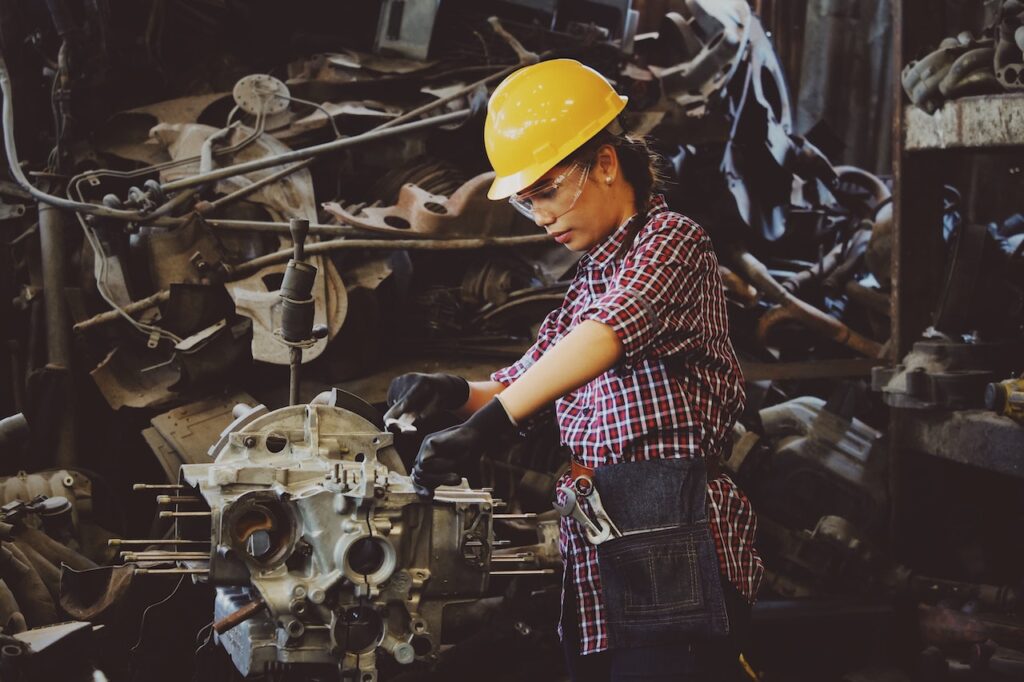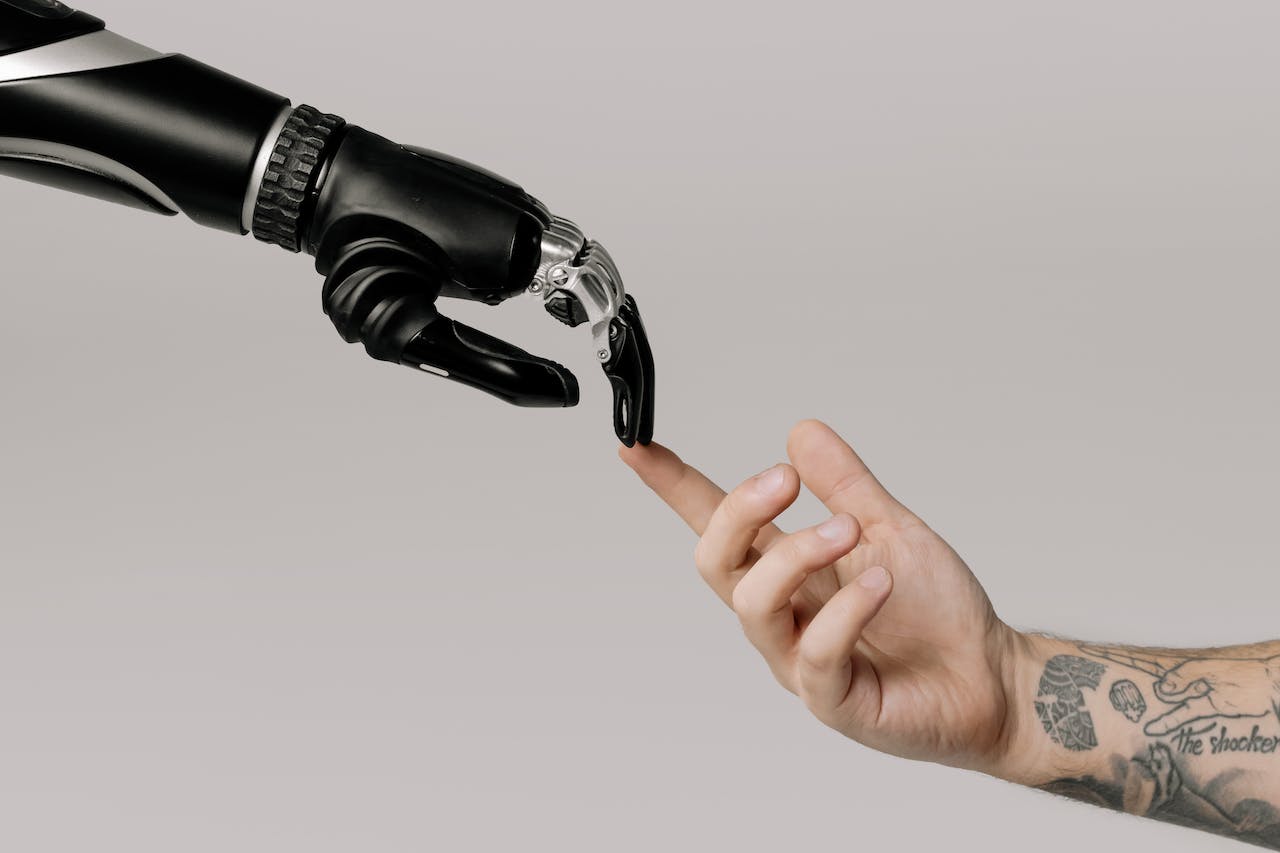I’m not an artificial intelligence (AI) expert. However, having helped build an AI-powered software tool for machine manufacturers, I became curious about AI in manufacturing.
I’m particularly curious about how AI should be used in manufacturing (if at all) and how it can help manufacturers.
Part of what sparked my curiosity is the conversations my team and I have had with manufacturers at various conferences. It appears to me that the concepts of AI in manufacturing are vastly misunderstood, and as a result, many resist adopting newer technologies.
Before I can discuss the possible benefits of AI in general and AI in manufacturing more specifically, it is important that manufacturers understand what AI is (and what it isn’t), how it came about, and a bit about how it works.
So, in this article, I’ll explore the role of AI in manufacturing, providing insights into what AI is, its brief history, the distinction between AI and Machine Learning, and how AI is shaping the future of manufacturing.
What is AI?
Artificial Intelligence (AI) has become a powerful force of transformation across various industries, and manufacturing is no exception.
Artificial Intelligence, often abbreviated as AI, refers to the simulation of human intelligence in machines.
This encompasses the ability of machines to perform tasks that typically require human intelligence, such as problem-solving, reasoning, learning, perception, and language understanding. AI technologies aim to create systems and machines that can mimic human cognitive functions, making decisions and taking actions based on data and algorithms.
AI encompasses a wide range of techniques and technologies, including but not limited to:
- Machine Learning: A subset of AI that enables systems to improve their performance on a task through learning from data without being explicitly programmed.
- Natural Language Processing (NLP): The ability of machines to understand, interpret, and generate human language.
- Computer Vision: The capability of machines to interpret and understand visual information from the world, such as images and videos.
- Expert Systems: AI systems that emulate the decision-making abilities of a human expert in a specific domain.
- Robotics: Combining AI and mechanical systems to create intelligent and autonomous robots.
In manufacturing, AI is primarily leveraged to enhance automation, optimize processes, and improve decision-making, leading to increased efficiency, reduced costs, and enhanced product quality.
A Brief History of AI
The journey of AI can be traced back to ancient myths and legends about artificially created beings that possess human-like intelligence. However, the formal development of AI as a field of study began in the mid-20th century.
Early Developments:
- Alan Turing’s Work (1936): The British mathematician and computer scientist Alan Turing introduced the concept of a theoretical machine that could simulate any other machine’s computation, which is now known as the Turing machine. This laid the theoretical foundation for AI.
- John McCarthy (1956): The term “Artificial Intelligence” was first coined by John McCarthy during the Dartmouth Conference in 1956. This event is considered the birth of AI as an academic field.
The AI Winter:
The early optimism surrounding AI was followed by a period known as the “AI Winter,” characterized by reduced funding and waning interest in the field due to overhyped expectations and insufficient technological progress. However, AI research continued quietly in the background.
Resurgence and Modern AI:
The resurgence of AI can be attributed to several factors:
- Machine Learning Advances: Machine Learning techniques, especially deep learning, gained prominence in the 21st century. Breakthroughs in neural networks and the availability of massive datasets contributed to significant progress in AI applications.
- Big Data and Computing Power: The availability of vast amounts of data and powerful computing hardware enabled AI systems to process and analyze data more effectively.
- Practical Applications: AI began demonstrating practical applications in various domains, including healthcare, finance, and manufacturing, leading to increased interest and investment.
Today, AI is experiencing unprecedented growth and innovation, with applications in nearly every aspect of our lives, including the manufacturing industry.
The Difference Between Machine Learning (ML) and Artificial Intelligence (AI)
First, let’s talk about the technical differences between the two. If you do a quick search on Google, you’ll more than likely come up with a definition similar to this one:
Artificial Intelligence (AI) and Machine Learning (ML) are related but distinct concepts. Here’s a breakdown of their differences:
Artificial Intelligence (AI): AI refers to the broader field of creating machines or systems that can perform tasks that would typically require human intelligence. It involves developing intelligent systems capable of perceiving, reasoning, learning, problem-solving, and making decisions. AI encompasses a wide range of techniques, algorithms, and methodologies to mimic human intelligence. It can include both rule-based programming and machine-learning approaches.
Machine Learning (ML): Machine Learning is a subset or subfield of AI that focuses on the development of algorithms and models that allow machines to learn and make predictions or decisions based on data without being explicitly programmed. ML algorithms enable computers to analyze and extract meaningful patterns from large datasets, learn from them, and improve their performance over time. ML systems are designed to automatically learn and adapt without human intervention.
In simpler terms, AI is the broader concept that aims to create intelligent machines capable of performing human-like tasks. ML, on the other hand, is a specific approach within AI that focuses on developing algorithms and models that allow machines to learn from data and make predictions or decisions based on that learning.
To put it in perspective, AI is like the field of study, while ML is one of the tools or techniques used within that field to enable machines to learn and make decisions. ML is a subset of AI, but AI can encompass other approaches beyond ML, such as expert systems, natural language processing, computer vision, and more.
These definitions are accurate; however, they tend to be technical and hard for the average person to understand. So, I decided to come up with an analogy to help people understand the difference better.
Artificial Intelligence (AI) is like the plant manager who oversees the entire operation. The plant manager has a broad set of skills and knowledge, enabling them to make critical decisions.
They can adapt to various situations, communicate with different departments, and maintain the overall efficiency of the plant. In a manufacturing context, AI would represent a comprehensive system that includes machine learning, robotics, natural language processing, and more. The overarching intelligence guides the entire factory, making high-level decisions and ensuring all processes work harmoniously.
Machine Learning (ML), on the other hand, is similar to a specialized worker within the manufacturing plant. This worker has a specific task, such as quality control. They’ve been trained to identify defects and anomalies in the products.
Over time, as they see more and more products, they become better at spotting issues and can adapt to new types of defects. This worker doesn’t make decisions about the entire plant’s operations; instead, they excel at their specific task and continuously improve their ability through experience and data. In this analogy, ML represents a specialized technology within the broader AI system that excels in learning from data to perform a specific task, like predicting equipment failures or detecting defects in real time during manufacturing processes.
I hope this analogy can help you understand the difference even more.
In manufacturing, both AI and Machine Learning play pivotal roles. Machine Learning is often used for predictive maintenance, quality control, and process optimization, while AI encompasses a more comprehensive set of applications, including autonomous robotics and intelligent decision support systems.
AI in manufacturing: How Can AI Help Manufacturers
The integration of AI into manufacturing processes offers a plethora of benefits and transformative potential. Manufacturers increasingly embrace AI technologies to streamline operations, reduce costs, enhance product quality, and remain competitive. Here are some of the ways AI is revolutionizing the manufacturing industry:
1. Predictive Maintenance:
AI-driven predictive maintenance uses sensors and data analytics to predict when equipment is likely to fail. By identifying potential issues before they cause downtime, manufacturers can avoid costly breakdowns, reduce maintenance costs, and ensure continuous production.
2. Quality Control:
AI-powered computer vision systems can inspect products with remarkable accuracy. These systems can detect defects, anomalies, and deviations in real-time, ensuring that only high-quality products reach the market.
3. Process Optimization:
AI algorithms can analyze vast datasets to optimize manufacturing processes. They can fine-tune parameters, such as machine settings and production schedules, to improve efficiency, reduce waste, and minimize energy consumption.
4. Supply Chain Management:
AI can enhance supply chain operations by optimizing inventory management, demand forecasting, and route planning. This results in reduced lead times, lower carrying costs, and improved customer satisfaction.
5. Autonomous Robotics:
Manufacturers are increasingly deploying autonomous robots and drones in their facilities. These robots can perform tasks such as material handling, assembly, and even complex operations like welding with precision and efficiency.
6. Natural Language Processing:
Incorporating natural language processing into manufacturing systems improves communication between humans and machines. This can streamline data entry, facilitate human-machine collaboration, and improve maintenance and troubleshooting processes.
7. Energy Efficiency:
AI can help manufacturers reduce their energy consumption by analyzing sensor data and optimizing equipment usage. Manufacturers can cut operational costs and reduce their environmental footprint by identifying and acting on energy-saving opportunities.
8. Customization and Personalization:
AI enables mass customization in manufacturing. It allows for the efficient production of customized products by adapting production lines and processes based on individual customer preferences and requirements.
9. Inventory Management:
AI in manufacturing can optimize inventory levels by forecasting demand and automatically replenishing stock when it reaches predefined thresholds. This results in reduced holding costs and minimizes the risk of stockouts.
10. Safety and Compliance:
AI in manufacturing can enhance safety in manufacturing environments by monitoring worker activities and identifying potential safety hazards. It can also assist in ensuring regulatory compliance through automated recordkeeping and reporting.
11. Decision Support:
Manufacturers can benefit from AI-powered decision support systems that provide real-time data analysis, insights, and recommendations to aid management in making informed decisions about production scheduling, resource allocation, or process improvement.
12. Waste Reduction:
AI can help identify and minimize waste in manufacturing processes, whether it’s in the form of material, time, or energy. This results in cost savings and a more sustainable approach to manufacturing.
AI in manufacturing: A more concrete example
Although the 12 examples mentioned earlier illustrate AI’s potential in manufacturing, let’s explore a more specific use case that showcases AI’s transformative power.
In many manufacturing settings, there is often an individual—whether a process engineer, a plant manager, or someone else—who possesses an exceptional understanding of how everything in the factory operates.
For the sake of this example, let’s call this individual James.

Also, for the sake of this example, let’s say that James can pinpoint issues and explain why machines fail with an impressive 70% degree of confidence.
However, no matter how skilled James is, his capacity for processing information is limited, usually to around 100 signals at a time (That is quite generous).
This is where AI and automated computer systems step in. They can process vast amounts of data, ranging from thousands to hundreds of thousands, and even millions of data points within a remarkably short time frame.
As a result, the integration of AI in manufacturing can significantly enhance this individual’s capabilities, boosting their confidence level from 70% to a substantial 90% or beyond. The increase could be less than 90%, or it could be more. Whatever the number is, this could be one of the promises of AI in manufacturing: A tool that helps experts become better experts with more accurate data.
In summary, the adoption of AI in manufacturing is revolutionizing the industry by optimizing processes, enhancing product quality, reducing operational costs, and providing manufacturers with a competitive edge in an ever-evolving global market.
As AI technologies continue to advance, the potential for innovation and growth in the manufacturing sector remains limitless. Manufacturers that embrace and leverage AI are poised to thrive in this era of intelligent manufacturing.



